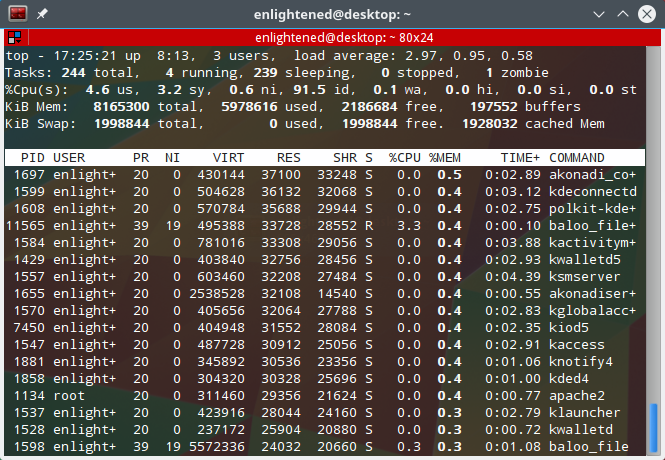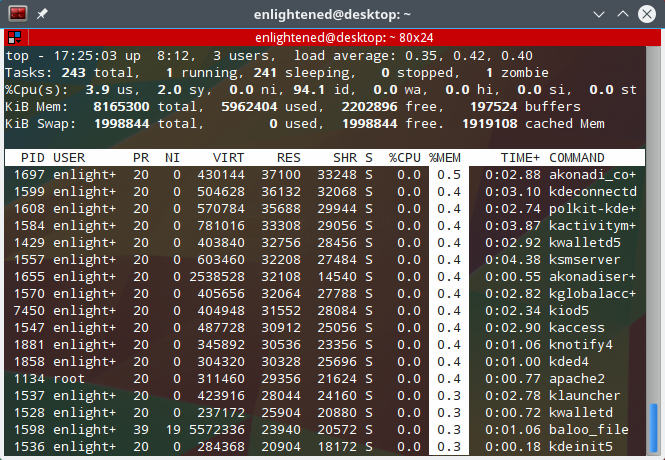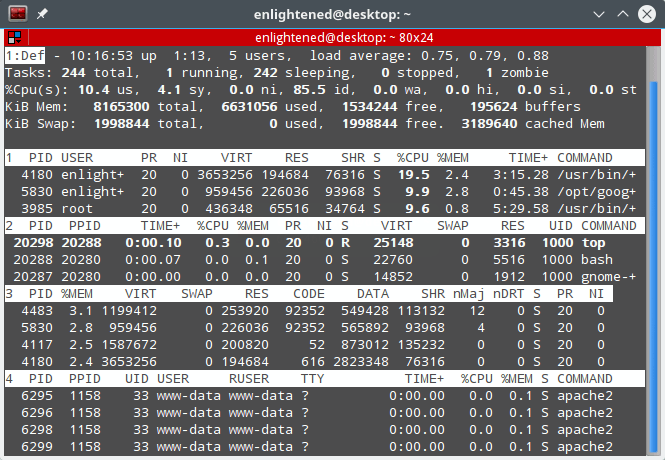The top command is one of the most basic commands for monitoring processes on Linux. It displays the top processes depending on factors such as cpu or memory consumption, as the name implies.
Processes are listed in a table with numerous columns for information such as process name, pid, user, cpu utilization, and memory consumption.
Aside from displaying a list of processes, the top command also displays brief statistics such as average system load, CPU use, and RAM consumption.
This tutorial will show you how to use the top command to monitor processes on your linux computer or server in a few easy examples.
Note your “top” command variant
Be aware that there are several variations of the top command. Each with a somewhat different set of arguments and methods of execution.
Use the -v option to examine the version and variation of your top command.
$ top -v
procps-ng version 3.3.9
The top command from the procps-ng project is the subject of this post. This is the version that most contemporary distros, such as Ubuntu, Fedora, and CentOS, use.
1. Display processes
To get a glimpse of the running processes, just run the top command as is without any options like this.
$ top
And immediately the output would be something like this –
top - 18:50:35 up 9:05, 5 users, load average: 0.68, 0.52, 0.39
Tasks: 254 total, 1 running, 252 sleeping, 0 stopped, 1 zombie
%Cpu(s): 2.3 us, 0.5 sy, 0.0 ni, 97.1 id, 0.2 wa, 0.0 hi, 0.0 si, 0.0 st
KiB Mem: 8165300 total, 6567896 used, 1597404 free, 219232 buffers
KiB Swap: 1998844 total, 0 used, 1998844 free. 2445372 cached Mem
PID USER PR NI VIRT RES SHR S %CPU %MEM TIME+ COMMAND
17952 enlight+ 20 0 1062096 363340 88068 S 4.8 4.4 0:49.33 chrome
14294 enlight+ 20 0 954752 203548 61404 S 2.1 2.5 2:00.91 chrome
1364 root 20 0 519048 105704 65348 S 0.6 1.3 17:31.27 Xorg
19211 enlight+ 20 0 576608 47216 39136 S 0.6 0.6 0:01.01 konsole
13 root rt 0 0 0 0 S 0.3 0.0 0:00.10 watchdog/1
25 root 20 0 0 0 0 S 0.3 0.0 0:03.49 rcuos/2
1724 enlight+ 20 0 430144 36456 32608 S 0.3 0.4 0:03.60 akonadi_contact
1869 enlight+ 20 0 534708 52700 38132 S 0.3 0.6 0:53.94 yakuake
14040 enlight+ 20 0 858176 133944 61152 S 0.3 1.6 0:09.89 chrome
A lot of information regarding the system is on the screen. Uptime, load average, CPU utilization, and memory usage data are all included in the header regions.
The process list shows all the processes with various process specific details in separate columns.
Some of the column names are pretty self explanatory.
PID – Process ID
USER – The system user account running the process.
%CPU – CPU usage by the process.
%MEM – Memory usage by the process
COMMAND – The command (executable file) of the process
2. Sort by Memory/Cpu/Process ID/Running Time
Sort the list to identify the process that uses the most CPU or memory.
To order the process list by memory consumption, press the M key (yes, capital, not small). The processes that use the most RAM are presented first, followed by the others in order.
Here are other options to sort by CPU usage, Process ID and Running Time –
- ‘P’ – to sort the process list by cpu usage.
- ‘N’ – to sort the list by process id
- ‘T’ – to sort by the running time.
3. Reverse the sorting order – ‘R’
The sorting is in descending order by default. By pressing ‘R,’ the sorting order of the presently sorted column will be reversed.
Here’s the output, ordered by CPU consumption in ascending order. The processes that use the least amount of CPU are displayed first.
top - 17:37:55 up 8:25, 3 users, load average: 0.74, 0.88, 0.74
Tasks: 245 total, 1 running, 243 sleeping, 0 stopped, 1 zombie
%Cpu(s): 5.2 us, 1.7 sy, 0.0 ni, 93.2 id, 0.0 wa, 0.0 hi, 0.0 si, 0.0 st
KiB Mem: 8165300 total, 6089388 used, 2075912 free, 199060 buffers
KiB Swap: 1998844 total, 0 used, 1998844 free. 1952412 cached Mem
PID USER PR NI VIRT RES SHR S %CPU %MEM TIME+ COMMAND
1 root 20 0 185308 6020 4012 S 0.0 0.1 0:01.90 systemd
2 root 20 0 0 0 0 S 0.0 0.0 0:00.00 kthreadd
3 root 20 0 0 0 0 S 0.0 0.0 0:00.16 ksoftirqd/0
5 root 0 -20 0 0 0 S 0.0 0.0 0:00.00 kworker/0:+
7 root 20 0 0 0 0 S 0.0 0.0 0:06.98 rcu_sched
8 root 20 0 0 0 0 S 0.0 0.0 0:00.00 rcu_bh
4. Highlight the sorted column with bold text – ‘x’
To highlight the values in the sort column in bold text, press x. Here’s an example of a snapshot with the memory column highlighted in bold language –

5. Highlight sorted column background color ‘b’
It’s also possible to highlight the sorted column with a different backdrop color after highlighting it with bold font. This is how it seems.

6. Change the update delay – ‘d’
By default, the top command refreshes the information on the screen every 3.0 seconds. This refresh interval is adjustable.
Top will ask you to input the time interval between each refresh if you press the ‘d’ key. You can also input fractions of a second, such as 0.5. Hit Enter after entering the appropriate interval.
top - 18:48:23 up 9:19, 3 users, load average: 0.27, 0.46, 0.39
Tasks: 254 total, 1 running, 252 sleeping, 0 stopped, 1 zombie
%Cpu(s): 1.3 us, 0.4 sy, 0.0 ni, 98.1 id, 0.2 wa, 0.0 hi, 0.0 si, 0.0 st
KiB Mem: 8165300 total, 7899784 used, 265516 free, 238068 buffers
KiB Swap: 1998844 total, 5432 used, 1993412 free. 3931316 cached Mem
Change delay from 3.0 to
PID USER PR NI VIRT RES SHR S %CPU %MEM TIME+ COMMAND
14512 enlight+ 20 0 1047688 302532 87156 S 1.3 3.7 1:34.87 /opt/googl+
15312 enlight+ 20 0 25148 3280 2628 R 0.8 0.0 0:00.04 top
7. Filter or Search processes – ‘o’/’O’
You can use several parameters to filter the process list, such as process name, memory utilization, and CPU usage. There are multiple filter criteria that can be used.
Press the ‘o’ or ‘O’ to activate filter prompt. It will show a line indicating the filter format like this –
add filter #1 (ignoring case) as: [!]FLD?VAL
Then enter a filter like this and hit Enter.
COMMAND=apache
Now top will show only those processes whose COMMAND field contains the value apache.
Here is another filter example that shows processes consuming CPU actively –
%CPU>0.0
See active filters – Press Ctrl+o to see currently active filters
Clear filter – Press ‘=’ key to clear any active filters
8. Display full command path and arguments of process – ‘c’
In the COMMAND column, press ‘c’ to see the full command path as well as the commandline parameters.
%CPU %MEM TIME+ COMMAND 0.0 0.0 0:00.00 /usr/bin/dbus-launch --exit-with-session /usr/bin/im-laun+ 0.0 0.1 0:01.52 /usr/bin/dbus-daemon --fork --print-pid 5 --print-address+ 0.0 0.3 0:00.41 /usr/bin/kwalletd --pam-login 17 20 0.0 0.0 0:00.00 /usr/lib/x86_64-linux-gnu/libexec/kf5/start_kdeinit --kde+ 0.0 0.3 0:01.55 klauncher [kdeinit5] --fd=9 0.0 0.2 0:00.13 /usr/lib/telepathy/mission-control-5 0.0 0.1 0:00.00 /usr/lib/dconf/dconf-service 0.0 0.4 0:01.41 /usr/lib/x86_64-linux-gnu/libexec/kdeconnectd 0.0 0.2 0:01.09 /usr/lib/x86_64-linux-gnu/libexec/kf5/kscreen_backend_lau+
9. View processes of a user – ‘u’/’U’
To view the processes of a specific user only, press ‘u’ and then top will ask you to enter the username.
Which user (blank for all)
Enter the desired username and hit Enter.
top - 17:33:46 up 8:21, 3 users, load average: 2.55, 1.31, 0.81
Tasks: 246 total, 1 running, 244 sleeping, 0 stopped, 1 zombie
%Cpu(s): 11.8 us, 3.3 sy, 0.6 ni, 84.2 id, 0.0 wa, 0.0 hi, 0.1 si, 0.0 st
KiB Mem: 8165300 total, 6108824 used, 2056476 free, 198680 buffers
KiB Swap: 1998844 total, 0 used, 1998844 free. 1963436 cached Mem
Which user (blank for all) enlightened
PID USER PR NI VIRT RES SHR S %CPU %MEM TIME+ COMMAND
1696 enlight+ 20 0 440728 37728 33724 S 0.0 0.5 0:03.12 akonadi_bi+
1705 enlight+ 20 0 430304 37156 33264 S 0.0 0.5 0:03.08 akonadi_mi+
1697 enlight+ 20 0 430144 37100 33248 S 0.0 0.5 0:03.00 akonadi_co+
1599 enlight+ 20 0 504628 36132 32068 S 0.0 0.4 0:03.24 kdeconnectd
1608 enlight+ 20 0 570784 35688 29944 S 0.0 0.4 0:02.87 polkit-kde+
1584 enlight+ 20 0 781016 33308 29056 S 0.0 0.4 0:04.03 kactivitym+
10. Toggle the display of idle processes – ‘i’
Press ‘i’ to toggle the display of idle/sleeping processes. By default all processes are display.
11. Hide/Show the information on top – ‘l’, ‘t’, ‘m’
The ‘l’ key would hide the load average information.
The ‘m’ key will hide the memory information.
The ‘t’ key would hide the task and cpu information.
Hiding the header information area, makes more processes visible in the list.
12. Forest mode – ‘V’
Pressing ‘V’ will display the processes in a parent child hierarchy. It looks something like this –
top - 09:29:34 up 17 min, 3 users, load average: 0.37, 0.58, 0.66
Tasks: 244 total, 1 running, 242 sleeping, 0 stopped, 1 zombie
%Cpu(s): 6.1 us, 2.1 sy, 0.0 ni, 91.8 id, 0.1 wa, 0.0 hi, 0.0 si, 0.0 st
KiB Mem: 8165300 total, 3968224 used, 4197076 free, 82868 buffers
KiB Swap: 1998844 total, 0 used, 1998844 free. 1008416 cached Mem
PID USER PR NI VIRT RES SHR S %CPU %MEM TIME+ COMMAND
1 root 20 0 37844 5964 4012 S 0.0 0.1 0:01.08 systemd
279 root 20 0 35376 4132 3732 S 0.0 0.1 0:00.22 `- systemd-journal
293 root 20 0 44912 4388 3100 S 0.0 0.1 0:00.14 `- systemd-udevd
493 systemd+ 20 0 102360 2844 2572 S 0.0 0.0 0:00.01 `- systemd-timesyn
614 root 20 0 337360 8624 6904 S 0.0 0.1 0:00.03 `- ModemManager
615 avahi 20 0 40188 3464 3096 S 0.0 0.0 0:00.01 `- avahi-daemon
660 avahi 20 0 40068 324 12 S 0.0 0.0 0:00.00 `- avahi-daem+
617 root 20 0 166276 8788 8076 S 0.0 0.1 0:00.07 `- thermald
621 root 20 0 15664 2496 2312 S 0.0 0.0 0:00.00 `- anacron
2792 root 20 0 4476 844 760 S 0.0 0.0 0:00.00 `- sh
2793 root 20 0 4364 684 604 S 0.0 0.0 0:00.00 `- run-pa+
2802 root 20 0 4476 1672 1536 S 0.0 0.0 0:00.00 `- apt
2838 root 20 0 7228 676 596 S 0.0 0.0 0:00.00 `+
630 root 20 0 28932 3128 2860 S 0.0 0.0 0:00.00 `- cron
634 root 20 0 283120 6776 5924 S 0.0 0.1 0:00.04 `- accounts-daemon
636 root 20 0 86160 7224 6128 S 0.0 0.1 0:00.01 `- cupsd
13. Change the number of processes to display – ‘n’
Lets say you want to monitor only few processes based on a certain filter criteria. Press ‘n’ and enter the number of processes you wish to display.
It will display a line saying –
Maximum tasks = 0, change to (0 is unlimited)
14. Display all CPU cores – ‘1’
Pressing ‘1’ will display the load information about individual cpu cores. Here is how it looks –
top - 10:45:47 up 1:42, 5 users, load average: 0.81, 1.14, 0.94
Tasks: 260 total, 2 running, 257 sleeping, 0 stopped, 1 zombie
%Cpu0 : 3.6 us, 3.6 sy, 0.0 ni, 92.9 id, 0.0 wa, 0.0 hi, 0.0 si, 0.0 st
%Cpu1 : 3.1 us, 3.6 sy, 0.0 ni, 93.3 id, 0.0 wa, 0.0 hi, 0.0 si, 0.0 st
%Cpu2 : 7.6 us, 1.8 sy, 0.0 ni, 90.7 id, 0.0 wa, 0.0 hi, 0.0 si, 0.0 st
%Cpu3 : 9.6 us, 2.6 sy, 0.0 ni, 87.7 id, 0.0 wa, 0.0 hi, 0.0 si, 0.0 st
KiB Mem: 8165300 total, 7118864 used, 1046436 free, 204224 buffers
KiB Swap: 1998844 total, 0 used, 1998844 free. 3410364 cached Mem
15. Show/Hide columns ‘f’
By default top displays only few columns out of many more that it can display. If you want to add or remove a particular column or change the order of columns, then press f
Fields Management for window 1:Def, whose current sort field is %CPU
Navigate with Up/Dn, Right selects for move then <Enter> or Left commits,
'd' or <Space> toggles display, 's' sets sort. Use 'q' or <Esc> to end!
* PID = Process Id PGRP = Process Group vMj = Major Faults
* USER = Effective Use TTY = Controlling T vMn = Minor Faults
PR = Priority TPGID = Tty Process G USED = Res+Swap Size
NI = Nice Value SID = Session Id nsIPC = IPC namespace
VIRT = Virtual Image nTH = Number of Thr nsMNT = MNT namespace
RES = Resident Size P = Last Used Cpu nsNET = NET namespace
SHR = Shared Memory TIME = CPU Time nsPID = PID namespace
S = Process Statu SWAP = Swapped Size nsUSER = USER namespac
* %CPU = CPU Usage CODE = Code Size (Ki nsUTS = UTS namespace
* %MEM = Memory Usage DATA = Data+Stack (K
TIME+ = CPU Time, hun nMaj = Major Page Fa
* COMMAND = Command Name/ nMin = Minor Page Fa
PPID = Parent Proces nDRT = Dirty Pages C
UID = Effective Use WCHAN = Sleeping in F
RUID = Real User Id Flags = Task Flags <s
RUSER = Real User Nam CGROUPS = Control Group
SUID = Saved User Id SUPGIDS = Supp Groups I
SUSER = Saved User Na SUPGRPS = Supp Groups N
GID = Group Id TGID = Thread Group
GROUP = Group Name ENVIRON = Environment v
The fields indicated with an asterisk (*) or bold are those that are presented in the order they occur in this list.
Use the up/down arrow keys to navigate the list, then hit ‘d’ to toggle the display of that field. Press q to return to the process list once you’ve finished.
Only the PID, USER, CPU, MEMORY, and COMMAND columns are shown in the following output.
top - 15:29:03 up 6:16, 4 users, load average: 0.99, 0.61, 0.63
Tasks: 247 total, 1 running, 245 sleeping, 0 stopped, 1 zombie
%Cpu(s): 6.3 us, 2.0 sy, 0.2 ni, 91.5 id, 0.1 wa, 0.0 hi, 0.0 si, 0.0 st
KiB Mem: 8165300 total, 6089244 used, 2076056 free, 189272 buffers
KiB Swap: 1998844 total, 0 used, 1998844 free. 1902836 cached Mem
PID USER %CPU %MEM COMMAND
1921 enlight+ 9.2 3.6 /opt/google/chrome/chrome
3078 enlight+ 6.9 4.2 /opt/google/chrome/chrome --type=renderer --lang=en-+
1231 root 5.3 1.0 /usr/bin/X :0 -auth /var/run/sddm/:0 -nolisten tcp -+
1605 enlight+ 2.8 2.5 /usr/bin/plasmashell --shut-up
1596 enlight+ 1.8 1.0 kwin_x11 -session 10d8d4e36b000144740943900000009530+
2088 enlight+ 0.9 1.7 /opt/google/chrome/chrome --type=renderer --lang=en-+
2534 enlight+ 0.8 1.7 /opt/google/chrome/chrome --type=renderer --lang=en-+
5695 enlight+ 0.8 0.7 /usr/bin/python /usr/bin/terminator
1859 enlight+ 0.2 1.2 /usr/bin/perl /usr/bin/shutter --min_at_startup
2060 enlight+ 0.2 1.5 /opt/google/chrome/chrome --type=renderer --lang=en-+
3541 enlight+ 0.2 3.6 /opt/google/chrome/chrome --type=renderer --lang=en-+
16. Batch mode
Top also supports batch mode output, which prints information in a sequential manner rather than on a single screen. This comes in handy when you need to save the top output for subsequent analysis.
Here’s a simple example that shows CPU utilization at 1 second intervals.
$ top -d 1.0 -b | grep Cpu
17. Split output in multiple panels – ‘A’
A different column can be used to sort each panel. To move through the panels, press ‘a’. Each panel can have a separate set of fields and sort columns displayed.

Top is an excellent command-line program for monitoring system resource utilization and process information. It’s frequently used on servers for monitoring and troubleshooting.
Try htop if you’re searching for something simpler with a nicer user experience. Htop provides an easy-to-use interface that eliminates the need to memorize keyboard shortcuts. Htop comes with onscreen instructions to help you get started.
Click here to read more useful and interesting articles.

